Answered step by step
Verified Expert Solution
Question
1 Approved Answer
Just need help with A,B, and C table 1 is the table with the yellow highlights The Chicken or The Egg: Hatching a New and
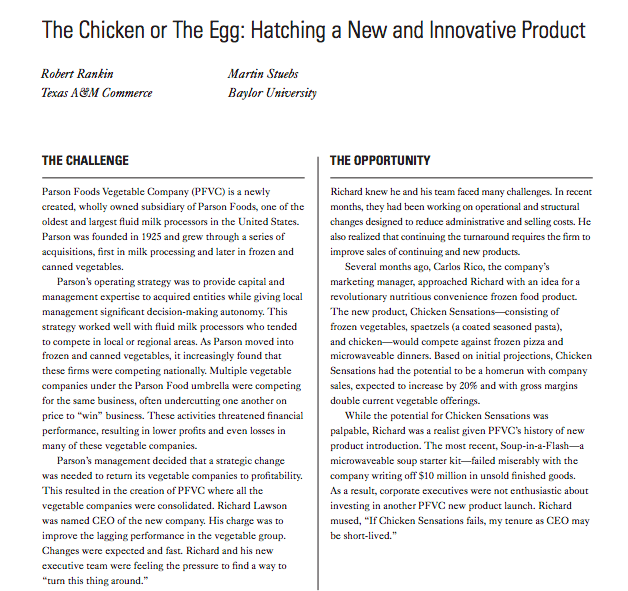
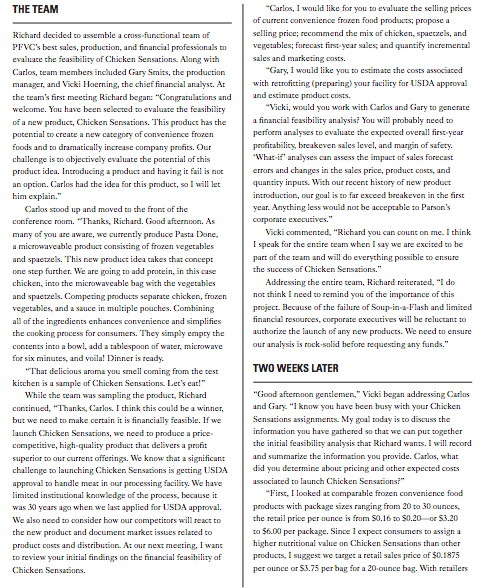
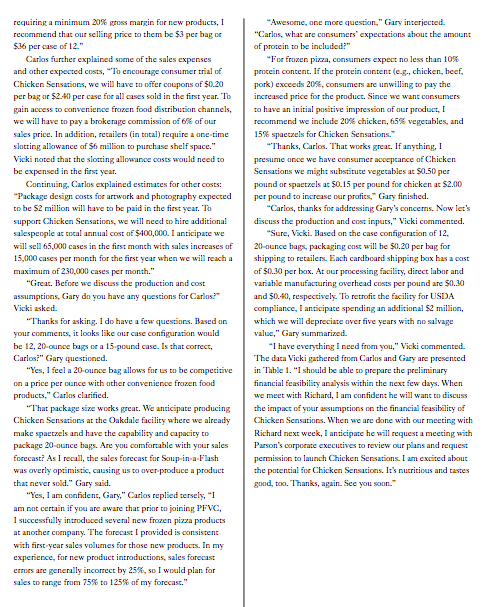
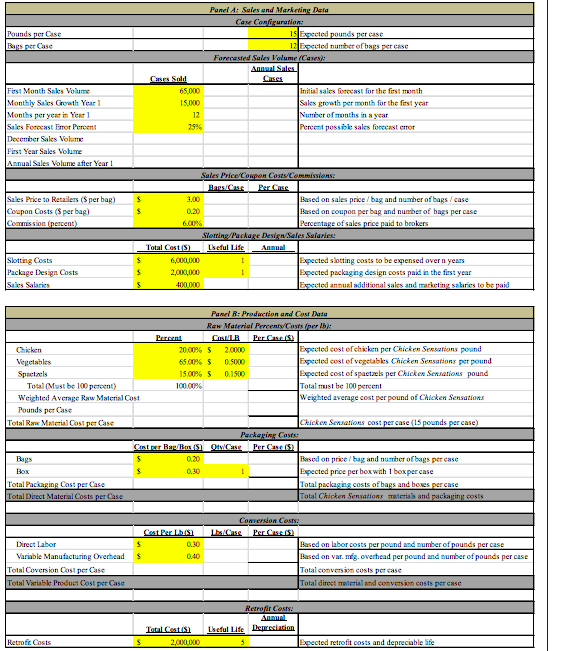
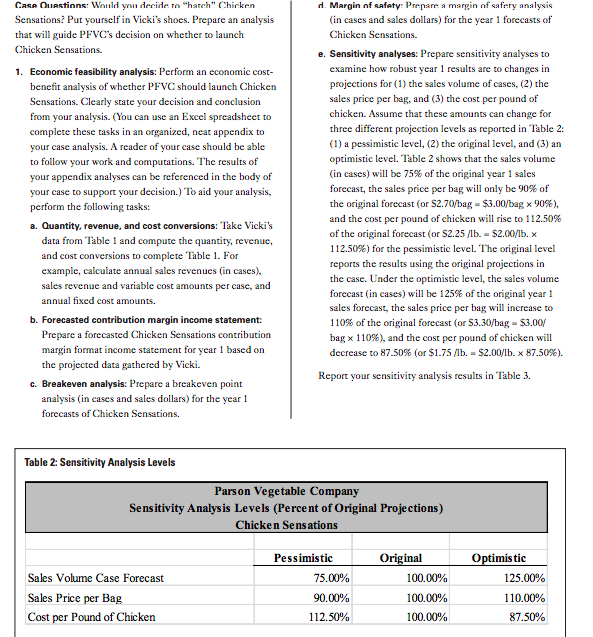
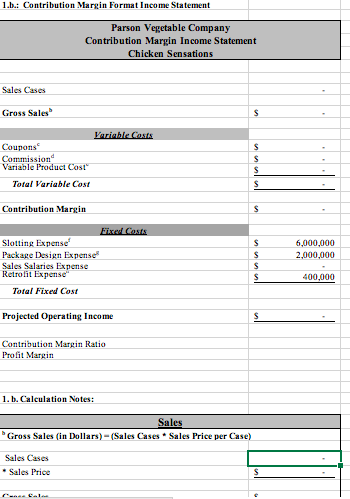
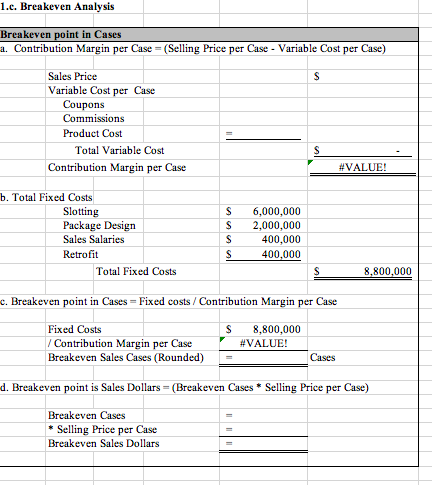
Just need help with A,B, and C table 1 is the table with the yellow highlights
The Chicken or The Egg: Hatching a New and Innovative Product Robert Rankin Texas A&M Commerce Martin Stuebs Baylor University THE CHALLENGE THE OPPORTUNITY Parson Foods Vegetable Company (PFVC) is a newly created, wholly owned subsidiary of Parson Foods, one of the oldest and largest fluid milk processors in the United States. Parson was founded in 1925 and grew through a series of acquisitions, first in milk processing and later in frozen and canned vegetables. Parson's operating strategy was to provide capital and management expertise to acquired entities while giving local management significant decision-making autonomy. This strategy worked well with fluid milk processors who tended to compete in local or regional areas. As Parson moved into frozen and canned vegetables, it increasingly found that these firms were competing nationally. Multiple vegetable companies under the Parson Food umbrella were competing for the same business, often undercutting one another on price to "win" business. These activities threatened financial performance, resulting in lower profits and even losses in many of these vegetable companies. Parson's management decided that a strategic change was needed to return its vegetable companies to profitability. This resulted in the creation of PFVC where all the vegetable companies were consolidated. Richard Lawson was named CEO of the new company. His charge was to improve the lagging performance in the vegetable group. Changes were expected and fast. Richard and his new executive team were feeling the pressure to find a way to "turn this thing around." Richard knew he and his team faced many challenges. In recent months, they had been working on operational and structural changes designed to reduce administrative and selling costs. He also realized that continuing the turnaround requires the firm to improve sales of continuing and new products. Several months ago, Carlos Rico, the company's marketing manager, approached Richard with an idea for a revolutionary nutritious convenience frozen food product. The new product, Chicken Sensations consisting of frozen vegetables, spaetzels (a coated seasoned pasta), and chickenwould compete against frozen pizza and microwaveable dinners. Based on initial projections, Chicken Sensations had the potential to be a homerun with company sales, expected to increase by 20% and with gross margins double current vegetable offerings. While the potential for Chicken Sensations was palpable, Richard was a realist given PFVC's history of new product introduction. The most recent, Soup-in-a-Flash- microwaveable soup starter kit-failed miserably with the company writing off $10 million in unsold finished goods. As a result, corporate executives were not enthusiastic about investing in another PFVC new product launch. Richard mused, "If Chicken Sensations fails, my tenure as CEO may be short-lived." THE TEAM Richard decided to assemble a cross-functional team of PFVC's best sales, production, and financial professionals to evaluate the feasibility of Chicken Sensations. Along with Carlos, team members included Gary Smits, the production manager, and Vicki Hoerning, the chief financial analyst. At the team's first meeting Richard began: "Congratulations and welcome. You have been selected to evaluate the feasibility of a new product, Chicken Sersations. This product has the potential to create a new category of convenience frozen foods and to dramatically increase company profits. Our challenge is to objectively evaluate the potential of this product idea. Introducing a product and having it fail is not an option. Carlos had the idea for this product, so I will let him explain." Carlos stood up and moved to the front of the conference room. Thanks, Richard. Good afternoon. As many of you are aware, we currently produce Pasta Done, a microwaveable product consisting of frozen vegetables and spactzels. This new product idea takes that concept one step further. We are going to add protein, in this case chicken into the microwaveable bag with the vegetables and spaetzels. Competing products separate chicken, frozen vegetables, and a sauce in multiple pouches. Combining all of the ingredients enhances convenience and simplifies the cooking process for consumers. They simply empty the contents into a bowl, add a tablespoon of water, microwave for six minutes, and voila! Dinner is ready "That delicious aroma you smell coming from the test kitchen is a sample of Chicken Sensations. Let's eat!" While the team was sampling the product, Richard continued, "Thanks, Carlos. I think this could be a winner, but we need to make certain it is financially feasible. If we launch Chicken Sensations, we need to produce a price competitive, high-quality product that delivers a profit superior to our current offerings. We know that a significant challenge to launching Chicken Sensations is getting USDA approval to handle meat in our processing facility. We have limited institutional knowledge of the process, because it was 30 years ago when we last applied for USDA approval. We also need to consider how our competitors will react to the new product and document market issues related to product costs and distribution. At our next meeting, I want to review your initial findings on the financial feasibility of Chicken Sensations. "Carlos, I would like for you to evaluate the selling prices of current convenience frozen food products, propose a selling price; recommend the mix of chicken, spaetzels, and vegetables; forecast first-year sales and quantify incremental sales and marketing costs. "Gary, I would like you to estimate the costs associated with retrofitting (preparing your facility for USDA approval and estimate product costs. "Vicki, would you work with Carlos and Gary to generate a financial feasibility analysis: You will probably need to perform analyses to evaluate the expected overall first year profitability, breakeven sales level, and margin of safety. "What if' analyses can assess the impact of sales forecast errors and changes in the sales price, product costs, and quantity inputs. With our recent history of new product introduction, our goal is to far exceed breakeven in the first year. Anything less would not be acceptable to Parson's corporate executives." Vicki commented, "Richard you can count on me. I think I speak for the entire team when I say we are excited to he part of the team and will do everything possible to ensure the success of Chicken Sensations." Addressing the entire team, Richard reiterated, "I do not think I need to remind you of the importance of this project. Because of the failure of Soup in a flash and limited financial resources, corporate executives will be reluctant to authorize the launch of any new products. We need to ensure cur analysis is pock-solid before requesting any funds." TWO WEEKS LATER "Good afternoon gentlemen, " Vicki began addressing Carlos and Gary "I know you have been busy with your Chicken Sensations assignments. My goal today is to discuss the information you have gathered so that we can put together the initial feasibility analysis that Richard wants. I will record and summarize the information you provide. Carlos, what did you determine about pricing and other expected costs associated to launch Chicken Sensations" "First, I looked at comparable frozen convenience food products with package Sizes ranging from 20 to 30 ounces, the retail price per ounce is from $0.16 to $0.20 O $3.20 to $6.00 per package. Since I expect consumers to assign a higher nutritional value on Chicken Sensations than other products, I suggest we target a retail sales price of $0.1875 per ounce or $3.75 per bag for a 20 ounce bag. With retailers requiring a minimum 20% gross margin for new products, recommend that our selling price to them be $3 per bag or $36 per case of 12." Carlos further explained some of the sales expenses and other expected costs, "To encourage consumer trial of Chicken Sensations, we will have to offer coupons of $0.20 per bag or $2.40 per case for all cases sold in the first year. To gain access to convenience frozen food distribution channels, we will have to pay a brokerage commission of 6 of our sales price. In addition, retailers (in total) require a one-time slotting allowance of $6 million to purchase shelf space." Vicki noted that the storing allowance costs would need to be expensed in the first year. Continuing, Carlos explained estimates for other costs: "Package design costs for artwork and photography expected to be 52 million will have to be paid in the first year. To support Chicken Sensations, we will need to hire additional salespeople at total annual cost of $400,000. I anticipate we will sell 65,000 cases in the first month with sales increases of 15,000 cases per month for the first year when we will reach a maximum of 230,000 cases per month." "Great. Before we discuss the production and cost assumptions, Gary do you have any questions for Carlos Vicki asked. "Thanks for asking. I do have a few questions. Based on your comments, it looks like our case configuration would be 12, 20-ounce bags or a 15-pound case. Is that correct, Carlosi" Gary questioned. "Yes, I feel a 20-ounce bag allows for us to be competitive on a price per ounce with other convenience frozen food products," Carlos clarified. "That package size works great. We anticipate producing Chicken Sensations at the Oakdale facility where we already make spaetzels and have the capability and capacity to package 20-ounce bags. Are you comfortable with your sales forecast? As I recall, the sales forecast for Soup-in-a-Flash was overly optimistic, causing us to over produce a product that never sold. Gary said. "Yes, I am confident, Gary," Carlos replied tersely, "I am not certain if you are aware that prior to joining PFVC, I successfully introduced several new frozen pizza products at another company. The forecast I provided is consistent with first-year sales volumes for those new products. In my experience, for new product introductions, sales forecast erroes are generally incorrect by 25%, so I would plan for sales to range from 75% to 125% of my forecast." "Awesome, one more question, Gary interjected. "Carlos, what are consumers' expectations about the amount of protein to be included?" *For frozen pizza, consumers expect no less than 10% procein content. If the protein content (e-g..chicken, heef, pork) exceeds 20%, consumers are unwilling to pay the increased price for the product. Since we want consumers to have an initial positive impression of our product, I recommend we include 20% chicken, 65 vegetables, and 15% spaetzels for Chicken Sensations." "Thanks, Carlos. That works great. If anything. I presume once we have consumer acceptance of Chicken Sensations we might substitute vegetables a $0.50 per pound or spaetzels ac $0.15 per pound for chicken at $2.00 per pound to increase our profits," Gary finished. "Carlos, thanks for addressing Gary's concerns. Now let's discuss the production and cost inputs," Vicki commented. "Sure, Vicki. Based on the case configuration of 12. 20-ounce bags, packaging cost will he $0.20 per bag for shipping to retailers. Each cardboard shipping box has a cast of $0.30 per box. At our processing facility, direct labor and variable manufacturing overhead costs per pound are $0.30 and $0.40, respectively. To retrofit the facility for USDA compliance, I anticipate spending an additional $2 million, which we will depreciate over five years with no salvage value," Gary summarized. "I have everything I need from you," Vicki commented. The data Vicki gathered from Carlos and Gary are presented in Table 1. "I should be able to prepare the preliminary financial feasibility analysis within the next few days. When we meet with Richard, I am confident he will want to discuss the impact of your assumptions on the financial feasibility of Chicken Sensations. When we are done with our meeting with Richard next week, I anticipate he will request a meeting with Parson's corporate executives to review our plans and request permission to launch Chicken Sensations. I am excited about the potential for Chicken Sensations. It's nutritious and tastes good, too. Thanks, again. See you soon." Pounds per se Panel 4: Seles and Marketing Data Case Configuration: IS Expected pounds percase 12 Espected number of bars Forecasted Sales Volume Cases Annual Sales Cases Sold 65.000 15.000 12 First Month Sales Volume Monthly Sales Growth Year 1 Months per year in Year! Sales Forecast Error Percent December Sales Volume First Year Sales Volume Annual Sales Volume after Year 1 Initial sales forecast for the first month Sales growth per month for the first year Number of months in year Percent possible sales forecast error $ Sales Price to Retailers (Sper bag) Coupon Costs (per bag) Commission (percent) Sales Price Coupon Costs Commissions Per Case Based on sales price / bag and number of bags/case Based on coupon per bag and number of bags per case Percentage of sales price paid to brokers Storting/Package Design Sales Solaries Total Cost (S) Useful Life Annual 6,000000 1 Expected slotting costs to be expensed overn years 2,000,000 Expected packaging design costs paid in the first year 400,000 Espected annual additional sales and marketing saries to be paid S Slotting Costs Package Design Costs Sales Salaries S $ Paul R: Production and CostData Ren Material Panas perib: Per Case Chicken 20.00% 5 2.0000 Expected cost of chicken per Chicken Sensations pound Vegetables 65.00% 5 0.5000 Expected cost of vegetables Chicken Sensations per pound Spactals 15.00% 5 0.1500 Expected cost of spaetzel per Chicker Sensations pound Total (Must be 100 percent) Total must be 100 percent Weighted Average Raw Material Cost Weighted average cost per pound of Chicken Sensations Pounds per Case Total Raw Material Cost per Case Chicken Sensations cost per case (15 pounds per case) Parkering Costs Carte Rap/ ROlCase Pers.) Bags Based on price/bag and number of bags per case Box S 0.30 Expected price per box with 1 box per case Total Packaging Cosi per Case Total packaging costs of bags and boxes per case Total Direct Material Costs per Case Total Chicken Sensations materials and packaging costs Cost Per $ 0.30 $ Direct Labor Variable Manufacturing Overhead Total Coversion Cost per Case Total Vieriable Product Cost per Case Conversion Cours: Per Case (5) Based on labor costs per pound and number of pounds per case Based on var.megoverhead per pound and number of pounds per case Total conversion costs per case Total direct material and conversion costs per ense Retrofit Costs: Annal Lactul Life Denteslation Total Costs 2.000.000 Retrofit Costs Expected retrofit costs and depreciable life Casa Questions: Would you decide to "harch" Chicken Sensations? Put yourself in Vicki's shoes. Prepare an analysis that will guide PFVC's decision on whether to launch Chicken Sensations. 1. Economic feasibility analysis: Perform an economic cost- benefit analysis of whether PFVC should launch Chicken Sensations. Clearly state your decision and conclusion from your analysis. (You can use an Excel spreadsheet to complete these tasks in an organized, neat appendix to your case analysis. A reader of your case should be able to follow your work and computations. The results of your appendix analyses can be referenced in the body of your case to support your decision.) To aid your analysis, perform the following tasks: a. Quantity, revenue, and cost conversions: Take Vicki's data from Table 1 and compute the quantity, revenue, and cost conversions to complete Table 1. For example, calculate annual sales revenues (in cases), sales revenue and variable cost amounts per case, and annual fixed cost amounts. b. Forecasted contribution margin income statement: Prepare a forecasted Chicken Sensations contribution margin format income statement for year 1 based on the projected data gathered by Vicki. c. Breakeven analysis: Prepare a breakeven point analysis (in cases and sales dollars) for the year 1 forecasts of Chicken Sensations. d. Margin of safety: Prepare a margin of safery analysis (in cases and sales dollars) for the year 1 forecasts of Chicken Sensations. e. Sensitivity analyses: Prepare sensitivity analyses to examine how robust year 1 results are to changes in projections for (1) the sales volume of cases, (2) the sales price per bag, and (3) the cost per pound of chicken. Assume that these amounts can change for three different projection levels as reported in Table 2: (1) a pessimistic level, (2) the original level, and (3) an optimistic level. Table 2 shows that the sales volume (in cases) will be 75% of the original year 1 sales forecast, the sales price per bag will only be 90% of the original forecast (or $2.70/bag = $3.00/bag x 90%), and the cost per pound of chicken will rise to 112.50% of the original forecast (or 52.25 /ib. = $2.00/1b. 112.50%) for the pessimistic level. The original level reports the results using the original projections in the case. Under the optimistic level, the sales volume forecast (in cases) will be 125% of the original year 1 sales forecast, the sales price per bag will increase to 110% of the original forecast (or $3.30/bag - $3.00/ bag x 110%), and the cost per pound of chicken will decrease to 87.50% (or $1.75 /lb. = $2.00/lb. x 87.50%). Report your sensitivity analysis results in Table 3. Table 2: Sensitivity Analysis Levels Parson Vegetable Company Sensitivity Analysis Levels (Percent of Original Projections) Chicken Sensations Pessimistic 75.00% Original 100.00% Optimistic 125.00% Sales Volume Case Forecast Sales Price per Bag Cost per Pound of Chicken 90.00% 100.00% 100.00% 110.00% 87.50% 112.50% 1.b.: Contribution Margin Format Income Statement Parson Vegetable Company Contribution Margin Income Statement Chicken Sensations Sales Cases Gross Sales S Variable Cox Coupons Commission Variable Product Costa Total Variable Cost s S S S Contribution Margin S Fixed Costs Slotting Expense Package Design Expense Sales Salaries Expense Retrofit Expense" Total Fixed Cost $ S S S 6,000,000 2,000,000 400,000 Projected Operating Income S Contribution Margin Ratio Profit Margin 1. b. Calculation Notes: Sales Gross Sales (in Dollars)-(Sales Cases Sales Price Case) Sales Cases Sales Price S 1.c. Breakeven Analysis Breakeven point in Cases a. Contribution Margin per Case = (Selling Price per Case - Variable Cost per Case) S Sales Price Variable Cost per Case Coupons Commissions Product Cost Total Variable Cost Contribution Margin per Case S #VALUE! b. Total Fixed Costs Slotting Package Design Sales Salaries Retrofit Total Fixed Costs S S S S 6,000,000 2,000,000 400,000 400,000 s 8,800,000 c. Breakeven point in Cases Fixed costs / Contribution Margin per Case S Fixed Costs / Contribution Margin per Case Breakeven Sales Cases (Rounded) 8,800,000 #VALUE! Cases d. Breakeven point is Sales Dollars = (Breakeven Cases * Selling Price per Case) Breakeven Cases * Selling Price per Case Breakeven Sales Dollars The Chicken or The Egg: Hatching a New and Innovative Product Robert Rankin Texas A&M Commerce Martin Stuebs Baylor University THE CHALLENGE THE OPPORTUNITY Parson Foods Vegetable Company (PFVC) is a newly created, wholly owned subsidiary of Parson Foods, one of the oldest and largest fluid milk processors in the United States. Parson was founded in 1925 and grew through a series of acquisitions, first in milk processing and later in frozen and canned vegetables. Parson's operating strategy was to provide capital and management expertise to acquired entities while giving local management significant decision-making autonomy. This strategy worked well with fluid milk processors who tended to compete in local or regional areas. As Parson moved into frozen and canned vegetables, it increasingly found that these firms were competing nationally. Multiple vegetable companies under the Parson Food umbrella were competing for the same business, often undercutting one another on price to "win" business. These activities threatened financial performance, resulting in lower profits and even losses in many of these vegetable companies. Parson's management decided that a strategic change was needed to return its vegetable companies to profitability. This resulted in the creation of PFVC where all the vegetable companies were consolidated. Richard Lawson was named CEO of the new company. His charge was to improve the lagging performance in the vegetable group. Changes were expected and fast. Richard and his new executive team were feeling the pressure to find a way to "turn this thing around." Richard knew he and his team faced many challenges. In recent months, they had been working on operational and structural changes designed to reduce administrative and selling costs. He also realized that continuing the turnaround requires the firm to improve sales of continuing and new products. Several months ago, Carlos Rico, the company's marketing manager, approached Richard with an idea for a revolutionary nutritious convenience frozen food product. The new product, Chicken Sensations consisting of frozen vegetables, spaetzels (a coated seasoned pasta), and chickenwould compete against frozen pizza and microwaveable dinners. Based on initial projections, Chicken Sensations had the potential to be a homerun with company sales, expected to increase by 20% and with gross margins double current vegetable offerings. While the potential for Chicken Sensations was palpable, Richard was a realist given PFVC's history of new product introduction. The most recent, Soup-in-a-Flash- microwaveable soup starter kit-failed miserably with the company writing off $10 million in unsold finished goods. As a result, corporate executives were not enthusiastic about investing in another PFVC new product launch. Richard mused, "If Chicken Sensations fails, my tenure as CEO may be short-lived." THE TEAM Richard decided to assemble a cross-functional team of PFVC's best sales, production, and financial professionals to evaluate the feasibility of Chicken Sensations. Along with Carlos, team members included Gary Smits, the production manager, and Vicki Hoerning, the chief financial analyst. At the team's first meeting Richard began: "Congratulations and welcome. You have been selected to evaluate the feasibility of a new product, Chicken Sersations. This product has the potential to create a new category of convenience frozen foods and to dramatically increase company profits. Our challenge is to objectively evaluate the potential of this product idea. Introducing a product and having it fail is not an option. Carlos had the idea for this product, so I will let him explain." Carlos stood up and moved to the front of the conference room. Thanks, Richard. Good afternoon. As many of you are aware, we currently produce Pasta Done, a microwaveable product consisting of frozen vegetables and spactzels. This new product idea takes that concept one step further. We are going to add protein, in this case chicken into the microwaveable bag with the vegetables and spaetzels. Competing products separate chicken, frozen vegetables, and a sauce in multiple pouches. Combining all of the ingredients enhances convenience and simplifies the cooking process for consumers. They simply empty the contents into a bowl, add a tablespoon of water, microwave for six minutes, and voila! Dinner is ready "That delicious aroma you smell coming from the test kitchen is a sample of Chicken Sensations. Let's eat!" While the team was sampling the product, Richard continued, "Thanks, Carlos. I think this could be a winner, but we need to make certain it is financially feasible. If we launch Chicken Sensations, we need to produce a price competitive, high-quality product that delivers a profit superior to our current offerings. We know that a significant challenge to launching Chicken Sensations is getting USDA approval to handle meat in our processing facility. We have limited institutional knowledge of the process, because it was 30 years ago when we last applied for USDA approval. We also need to consider how our competitors will react to the new product and document market issues related to product costs and distribution. At our next meeting, I want to review your initial findings on the financial feasibility of Chicken Sensations. "Carlos, I would like for you to evaluate the selling prices of current convenience frozen food products, propose a selling price; recommend the mix of chicken, spaetzels, and vegetables; forecast first-year sales and quantify incremental sales and marketing costs. "Gary, I would like you to estimate the costs associated with retrofitting (preparing your facility for USDA approval and estimate product costs. "Vicki, would you work with Carlos and Gary to generate a financial feasibility analysis: You will probably need to perform analyses to evaluate the expected overall first year profitability, breakeven sales level, and margin of safety. "What if' analyses can assess the impact of sales forecast errors and changes in the sales price, product costs, and quantity inputs. With our recent history of new product introduction, our goal is to far exceed breakeven in the first year. Anything less would not be acceptable to Parson's corporate executives." Vicki commented, "Richard you can count on me. I think I speak for the entire team when I say we are excited to he part of the team and will do everything possible to ensure the success of Chicken Sensations." Addressing the entire team, Richard reiterated, "I do not think I need to remind you of the importance of this project. Because of the failure of Soup in a flash and limited financial resources, corporate executives will be reluctant to authorize the launch of any new products. We need to ensure cur analysis is pock-solid before requesting any funds." TWO WEEKS LATER "Good afternoon gentlemen, " Vicki began addressing Carlos and Gary "I know you have been busy with your Chicken Sensations assignments. My goal today is to discuss the information you have gathered so that we can put together the initial feasibility analysis that Richard wants. I will record and summarize the information you provide. Carlos, what did you determine about pricing and other expected costs associated to launch Chicken Sensations" "First, I looked at comparable frozen convenience food products with package Sizes ranging from 20 to 30 ounces, the retail price per ounce is from $0.16 to $0.20 O $3.20 to $6.00 per package. Since I expect consumers to assign a higher nutritional value on Chicken Sensations than other products, I suggest we target a retail sales price of $0.1875 per ounce or $3.75 per bag for a 20 ounce bag. With retailers requiring a minimum 20% gross margin for new products, recommend that our selling price to them be $3 per bag or $36 per case of 12." Carlos further explained some of the sales expenses and other expected costs, "To encourage consumer trial of Chicken Sensations, we will have to offer coupons of $0.20 per bag or $2.40 per case for all cases sold in the first year. To gain access to convenience frozen food distribution channels, we will have to pay a brokerage commission of 6 of our sales price. In addition, retailers (in total) require a one-time slotting allowance of $6 million to purchase shelf space." Vicki noted that the storing allowance costs would need to be expensed in the first year. Continuing, Carlos explained estimates for other costs: "Package design costs for artwork and photography expected to be 52 million will have to be paid in the first year. To support Chicken Sensations, we will need to hire additional salespeople at total annual cost of $400,000. I anticipate we will sell 65,000 cases in the first month with sales increases of 15,000 cases per month for the first year when we will reach a maximum of 230,000 cases per month." "Great. Before we discuss the production and cost assumptions, Gary do you have any questions for Carlos Vicki asked. "Thanks for asking. I do have a few questions. Based on your comments, it looks like our case configuration would be 12, 20-ounce bags or a 15-pound case. Is that correct, Carlosi" Gary questioned. "Yes, I feel a 20-ounce bag allows for us to be competitive on a price per ounce with other convenience frozen food products," Carlos clarified. "That package size works great. We anticipate producing Chicken Sensations at the Oakdale facility where we already make spaetzels and have the capability and capacity to package 20-ounce bags. Are you comfortable with your sales forecast? As I recall, the sales forecast for Soup-in-a-Flash was overly optimistic, causing us to over produce a product that never sold. Gary said. "Yes, I am confident, Gary," Carlos replied tersely, "I am not certain if you are aware that prior to joining PFVC, I successfully introduced several new frozen pizza products at another company. The forecast I provided is consistent with first-year sales volumes for those new products. In my experience, for new product introductions, sales forecast erroes are generally incorrect by 25%, so I would plan for sales to range from 75% to 125% of my forecast." "Awesome, one more question, Gary interjected. "Carlos, what are consumers' expectations about the amount of protein to be included?" *For frozen pizza, consumers expect no less than 10% procein content. If the protein content (e-g..chicken, heef, pork) exceeds 20%, consumers are unwilling to pay the increased price for the product. Since we want consumers to have an initial positive impression of our product, I recommend we include 20% chicken, 65 vegetables, and 15% spaetzels for Chicken Sensations." "Thanks, Carlos. That works great. If anything. I presume once we have consumer acceptance of Chicken Sensations we might substitute vegetables a $0.50 per pound or spaetzels ac $0.15 per pound for chicken at $2.00 per pound to increase our profits," Gary finished. "Carlos, thanks for addressing Gary's concerns. Now let's discuss the production and cost inputs," Vicki commented. "Sure, Vicki. Based on the case configuration of 12. 20-ounce bags, packaging cost will he $0.20 per bag for shipping to retailers. Each cardboard shipping box has a cast of $0.30 per box. At our processing facility, direct labor and variable manufacturing overhead costs per pound are $0.30 and $0.40, respectively. To retrofit the facility for USDA compliance, I anticipate spending an additional $2 million, which we will depreciate over five years with no salvage value," Gary summarized. "I have everything I need from you," Vicki commented. The data Vicki gathered from Carlos and Gary are presented in Table 1. "I should be able to prepare the preliminary financial feasibility analysis within the next few days. When we meet with Richard, I am confident he will want to discuss the impact of your assumptions on the financial feasibility of Chicken Sensations. When we are done with our meeting with Richard next week, I anticipate he will request a meeting with Parson's corporate executives to review our plans and request permission to launch Chicken Sensations. I am excited about the potential for Chicken Sensations. It's nutritious and tastes good, too. Thanks, again. See you soon." Pounds per se Panel 4: Seles and Marketing Data Case Configuration: IS Expected pounds percase 12 Espected number of bars Forecasted Sales Volume Cases Annual Sales Cases Sold 65.000 15.000 12 First Month Sales Volume Monthly Sales Growth Year 1 Months per year in Year! Sales Forecast Error Percent December Sales Volume First Year Sales Volume Annual Sales Volume after Year 1 Initial sales forecast for the first month Sales growth per month for the first year Number of months in year Percent possible sales forecast error $ Sales Price to Retailers (Sper bag) Coupon Costs (per bag) Commission (percent) Sales Price Coupon Costs Commissions Per Case Based on sales price / bag and number of bags/case Based on coupon per bag and number of bags per case Percentage of sales price paid to brokers Storting/Package Design Sales Solaries Total Cost (S) Useful Life Annual 6,000000 1 Expected slotting costs to be expensed overn years 2,000,000 Expected packaging design costs paid in the first year 400,000 Espected annual additional sales and marketing saries to be paid S Slotting Costs Package Design Costs Sales Salaries S $ Paul R: Production and CostData Ren Material Panas perib: Per Case Chicken 20.00% 5 2.0000 Expected cost of chicken per Chicken Sensations pound Vegetables 65.00% 5 0.5000 Expected cost of vegetables Chicken Sensations per pound Spactals 15.00% 5 0.1500 Expected cost of spaetzel per Chicker Sensations pound Total (Must be 100 percent) Total must be 100 percent Weighted Average Raw Material Cost Weighted average cost per pound of Chicken Sensations Pounds per Case Total Raw Material Cost per Case Chicken Sensations cost per case (15 pounds per case) Parkering Costs Carte Rap/ ROlCase Pers.) Bags Based on price/bag and number of bags per case Box S 0.30 Expected price per box with 1 box per case Total Packaging Cosi per Case Total packaging costs of bags and boxes per case Total Direct Material Costs per Case Total Chicken Sensations materials and packaging costs Cost Per $ 0.30 $ Direct Labor Variable Manufacturing Overhead Total Coversion Cost per Case Total Vieriable Product Cost per Case Conversion Cours: Per Case (5) Based on labor costs per pound and number of pounds per case Based on var.megoverhead per pound and number of pounds per case Total conversion costs per case Total direct material and conversion costs per ense Retrofit Costs: Annal Lactul Life Denteslation Total Costs 2.000.000 Retrofit Costs Expected retrofit costs and depreciable life Casa Questions: Would you decide to "harch" Chicken Sensations? Put yourself in Vicki's shoes. Prepare an analysis that will guide PFVC's decision on whether to launch Chicken Sensations. 1. Economic feasibility analysis: Perform an economic cost- benefit analysis of whether PFVC should launch Chicken Sensations. Clearly state your decision and conclusion from your analysis. (You can use an Excel spreadsheet to complete these tasks in an organized, neat appendix to your case analysis. A reader of your case should be able to follow your work and computations. The results of your appendix analyses can be referenced in the body of your case to support your decision.) To aid your analysis, perform the following tasks: a. Quantity, revenue, and cost conversions: Take Vicki's data from Table 1 and compute the quantity, revenue, and cost conversions to complete Table 1. For example, calculate annual sales revenues (in cases), sales revenue and variable cost amounts per case, and annual fixed cost amounts. b. Forecasted contribution margin income statement: Prepare a forecasted Chicken Sensations contribution margin format income statement for year 1 based on the projected data gathered by Vicki. c. Breakeven analysis: Prepare a breakeven point analysis (in cases and sales dollars) for the year 1 forecasts of Chicken Sensations. d. Margin of safety: Prepare a margin of safery analysis (in cases and sales dollars) for the year 1 forecasts of Chicken Sensations. e. Sensitivity analyses: Prepare sensitivity analyses to examine how robust year 1 results are to changes in projections for (1) the sales volume of cases, (2) the sales price per bag, and (3) the cost per pound of chicken. Assume that these amounts can change for three different projection levels as reported in Table 2: (1) a pessimistic level, (2) the original level, and (3) an optimistic level. Table 2 shows that the sales volume (in cases) will be 75% of the original year 1 sales forecast, the sales price per bag will only be 90% of the original forecast (or $2.70/bag = $3.00/bag x 90%), and the cost per pound of chicken will rise to 112.50% of the original forecast (or 52.25 /ib. = $2.00/1b. 112.50%) for the pessimistic level. The original level reports the results using the original projections in the case. Under the optimistic level, the sales volume forecast (in cases) will be 125% of the original year 1 sales forecast, the sales price per bag will increase to 110% of the original forecast (or $3.30/bag - $3.00/ bag x 110%), and the cost per pound of chicken will decrease to 87.50% (or $1.75 /lb. = $2.00/lb. x 87.50%). Report your sensitivity analysis results in Table 3. Table 2: Sensitivity Analysis Levels Parson Vegetable Company Sensitivity Analysis Levels (Percent of Original Projections) Chicken Sensations Pessimistic 75.00% Original 100.00% Optimistic 125.00% Sales Volume Case Forecast Sales Price per Bag Cost per Pound of Chicken 90.00% 100.00% 100.00% 110.00% 87.50% 112.50% 1.b.: Contribution Margin Format Income Statement Parson Vegetable Company Contribution Margin Income Statement Chicken Sensations Sales Cases Gross Sales S Variable Cox Coupons Commission Variable Product Costa Total Variable Cost s S S S Contribution Margin S Fixed Costs Slotting Expense Package Design Expense Sales Salaries Expense Retrofit Expense" Total Fixed Cost $ S S S 6,000,000 2,000,000 400,000 Projected Operating Income S Contribution Margin Ratio Profit Margin 1. b. Calculation Notes: Sales Gross Sales (in Dollars)-(Sales Cases Sales Price Case) Sales Cases Sales Price S 1.c. Breakeven Analysis Breakeven point in Cases a. Contribution Margin per Case = (Selling Price per Case - Variable Cost per Case) S Sales Price Variable Cost per Case Coupons Commissions Product Cost Total Variable Cost Contribution Margin per Case S #VALUE! b. Total Fixed Costs Slotting Package Design Sales Salaries Retrofit Total Fixed Costs S S S S 6,000,000 2,000,000 400,000 400,000 s 8,800,000 c. Breakeven point in Cases Fixed costs / Contribution Margin per Case S Fixed Costs / Contribution Margin per Case Breakeven Sales Cases (Rounded) 8,800,000 #VALUE! Cases d. Breakeven point is Sales Dollars = (Breakeven Cases * Selling Price per Case) Breakeven Cases * Selling Price per Case Breakeven Sales DollarsStep by Step Solution
There are 3 Steps involved in it
Step: 1

Get Instant Access to Expert-Tailored Solutions
See step-by-step solutions with expert insights and AI powered tools for academic success
Step: 2

Step: 3

Ace Your Homework with AI
Get the answers you need in no time with our AI-driven, step-by-step assistance
Get Started


